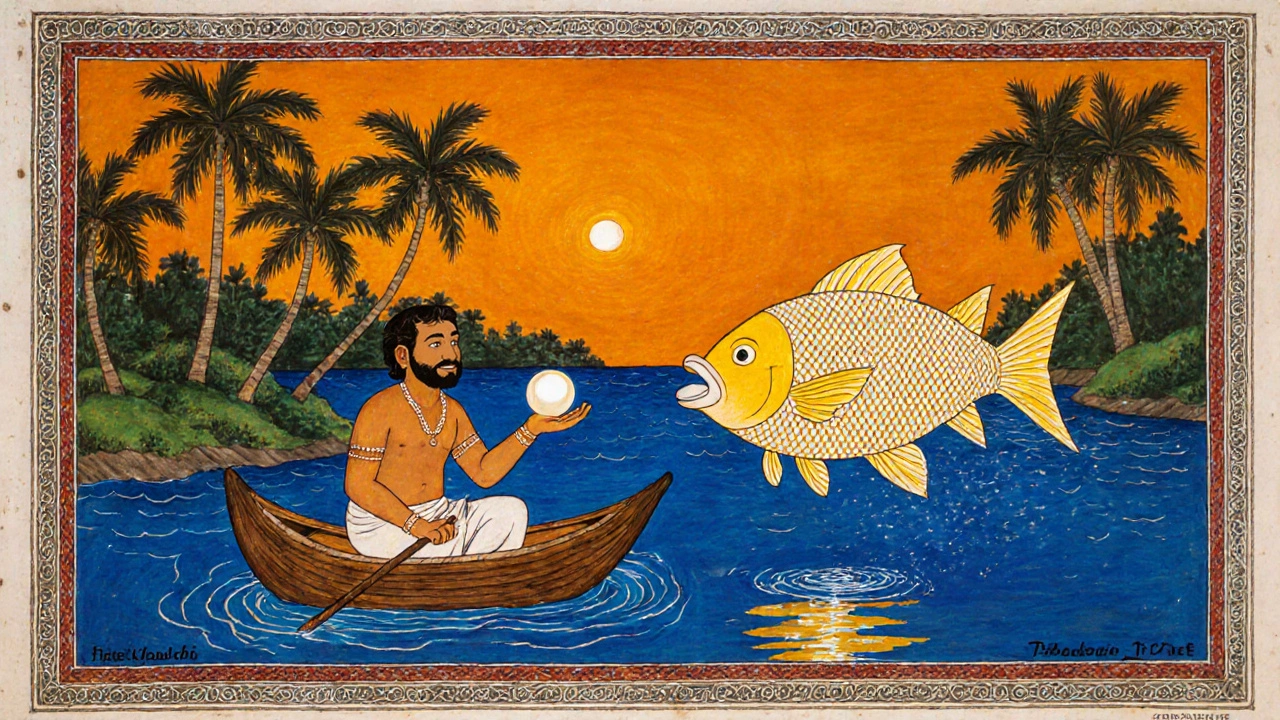Quick Takeaways
- The Indian mermaid is popularly known as the Jalpari, a water spirit found throughout regional folklore.
- Jalpari shares traits with other half‑human, half‑fish beings like the Kinnara and Apsara, but remains distinct in form and myth.
- Stories of Jalpari appear in Kerala, Bengal, Tamil Nadu and other states, each adding local flavor.
- These myths often teach respect for water, warn against hubris, and celebrate the mystery of the deep.
- Understanding the Jalpari gives insight into how Indian folklore blends nature worship with moral lessons.
Within Indian folklore is a rich tapestry of stories that span centuries, regions, and religions. Among its many characters is the Jalpari, a water spirit often likened to a mermaid Indian folklore. The name itself means “water fairy” in Hindi, and the creature drifts between riverbanks, lagoons, and coastal waters, enchanting or terrifying listeners depending on the tale.
What the Jalpari Represents
The Jalpari is not just a fanciful sea maid; she embodies the ancient Indian reverence for water as a life‑giving, yet unpredictable force. In many stories, she appears as a beautiful woman with a shimmering fish tail, singing melodic chants that lure careless travelers. Those who respect the water may receive a blessing-a safe crossing, a bountiful fish catch-while the arrogant or wasteful often meet a tragic end.
Scholars trace the Jalpari’s origins to the Vedic concept of Apsara, celestial nymphs who descend to earth’s rivers and lakes to dance and sing. Over time, as regional cultures infused their own aquatic beliefs, the Apsara’s attributes merged with local river deities, producing the distinct Jalpari figure.
Regional Names and Variations
India’s linguistic diversity means the mermaid‑like spirit carries many names:
- Jalpari - North India, Hindi‑speaking regions.
- Kadalchi - Kerala’s Malayalam tradition, emphasizing her connection to the sea (kadal).
- Poonam - Tamil folklore, where she is sometimes called “Kaveri Maiden” for her link to the sacred Kaveri River.
- Moyna - Bengali tales, depicting her as a moon‑lit swimmer who appears on misty evenings.
- Saudhu - Assamese stories, often a guardian of riverbanks.
Even though the names differ, the core imagery-a woman with a fish tail, a voice that echoes through water-remains consistent.
Mythic Cousins: Kinnara, Apsara, and Naga
To better understand the Jalpari, compare her with three other half‑human, half‑nature beings that appear across Indian mythology:
| Name | Typical Form | Primary Region | Key Traits |
|---|---|---|---|
| Jalpari | Half‑woman, half‑fish | North & South India (rivers & coasts) | Enchanting song, water guardian, moral tester |
| Kinnara | Half‑human, half‑bird | Hindu & Buddhist texts, Himalayan region | Musical skill, celestial messenger, benevolent |
| Apsara | Divine female, fully human in shape | All of India, especially temples | Dance, seduction, heavenly delight |
| Naga | Half‑human, half‑snake | North-East, South coastal states | Guardians of treasure, rain bringers, sometimes hostile |
While the Kinnara soars in the sky and the Naga coils in the earth, the Jalpari stays bound to water. This elemental tie defines her stories and the lessons they carry.

Popular Stories Featuring the Jalpari
Here are three well‑known tales that illustrate the character’s moral purpose:
- The Fisherman’s Promise - In a coastal village of Kerala, a humble fisherman catches a glowing fish. When the fish pleads for release, the fisherman refuses, citing hunger. The next night, a Kadalchi appears, offering a pearl in exchange for the fish’s life. The fisherman’s greed leads to the pearl turning to sand, and the sea swallows his boat. The story warns against exploiting nature’s gifts.
- The Bride Who Married a Jalpari - A Bengali tale tells of a young woman who, while fetching water, meets a Moyna singing by the river. Enchanted, she agrees to marry the spirit. The wedding takes place at sunrise, but when she attempts to return to human life, she is forever bound to the river, becoming the river’s guardian herself. The narrative highlights the tension between love for the supernatural and duty to the human world.
- The Temple’s Sacred Pool - In Tamil Nadu, a temple’s sacred tank is believed to be watched over by a Poonam. Pilgrims who throw litter into the water report sudden chills and a faint melodic voice urging them to clean the tank. Over time, the community adopts strict cleanliness rules, preserving the tank’s sanctity. The myth reinforces communal responsibility toward water sources.
Each story showcases how the Jalpari functions as a cultural checkpoint-testing humility, respecting the environment, and reinforcing social cohesion.
How the Indian Mermaid Differs from Global Counterparts
When people think of mermaids, they often recall the Euro‑centric image of a siren luring sailors to doom. The Indian Jalpari, while sometimes dangerous, is more nuanced. She can be a benefactor, a teacher, or a warning sign. Unlike the Western siren, whose primary role is to enchant and destroy, the Jalpari balances enchantment with ethical instruction.
Another distinction lies in her connection to Hindu cosmology. The Jalpari’s lineage traces back to celestial beings (Apsaras) and to local river deities (Varuna’s attendants). This divine ancestry embeds her within a larger religious framework rather than existing as a standalone monster.
Common Motifs and Symbolism
- Water as a Mirror - The Jalpari often appears when a character looks into a pond or river, symbolizing self‑reflection and inner truth.
- Music and Voice - Her songs carry hidden messages, echoing the belief that sound can influence the natural world.
- Duality of Beauty and Danger - The glittering scales attract, yet the deep water can swallow the unwary, representing life’s paradoxes.
- Offer and Exchange - Many myths involve a trade (e.g., a pearl for a life), highlighting the principle of reciprocity.

Mini FAQ
Frequently Asked Questions
Is the Jalpari the same as a mermaid?
The Jalpari shares the half‑woman, half‑fish appearance of a mermaid, but her stories are rooted in Indian cultural values, emphasizing respect for water and moral choices rather than just danger.
Where do these legends originate?
They arise from ancient Hindu texts, regional oral traditions, and local rituals across states like Kerala, Bengal, Tamil Nadu, and Assam.
Can the Jalpari be seen today?
People claim sightings during festivals near rivers, but most accounts are symbolic-performed by dancers or storytellers to keep the legend alive.
How does the Jalpari differ from the Kinnara?
Kinnara are sky‑bound, half‑human half‑bird musicians, while Jalpari are bound to water, using song to influence humans who approach rivers or the sea.
What moral lessons do Jalpari stories teach?
They stress humility before nature, the importance of keeping waterways clean, and the idea that selfish actions can bring unexpected punishment.
Next Steps for Curious Readers
If you’re intrigued by the Jalpari, try these actions:
- Visit a local river or coastal shrine during early morning; listen for the subtle chants of traditional boatmen.
- Read regional collections like the "Kerala Folk Tales" or "Bengali Legends" to see the Jalpari in context.
- Attend a cultural performance-many Indian dance forms such as Bharatanatyam and Kathak include Jalpari scenes.
- Explore scholarly articles on water deities in South Asian mythology for deeper academic insight.
Understanding the Jalpari does more than satisfy curiosity; it connects you to a worldview where every ripple in water might carry a story waiting to be heard.
